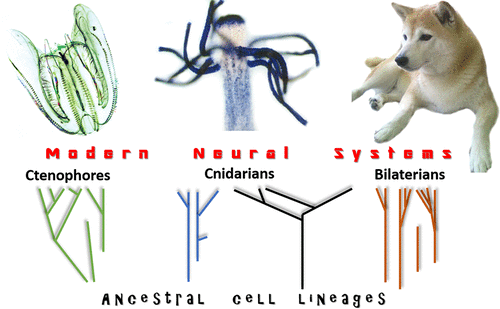当前位置:
X-MOL 学术
›
ACS Chem. Neurosci.
›
论文详情
Our official English website, www.x-mol.net, welcomes your feedback! (Note: you will need to create a separate account there.)
NeuroSystematics and Periodic System of Neurons: Model vs Reference Species at Single-Cell Resolution
ACS Chemical Neuroscience ( IF 5 ) Pub Date : 2018-07-10 00:00:00 , DOI: 10.1021/acschemneuro.8b00100 Leonid L. Moroz 1, 2
ACS Chemical Neuroscience ( IF 5 ) Pub Date : 2018-07-10 00:00:00 , DOI: 10.1021/acschemneuro.8b00100 Leonid L. Moroz 1, 2
Affiliation

|
There is more than one way to develop neuronal complexity, and animals frequently use different molecular toolkits to achieve similar functional outcomes (=convergent evolution). Neurons are different not only because they have different functions, but also because neurons and circuits have different genealogies, and perhaps independent origins at the broadest scale from ctenophores and cnidarians to cephalopods and primates. By combining modern phylogenomics, single-neuron sequencing (scRNA-seq), machine learning, single-cell proteomics, and metabolomic across Metazoa, it is possible to reconstruct the evolutionary histories of neurons tracing them to ancestral secretory cells. Comparative data suggest that neurons, and perhaps synapses, evolved at least 2-3 times (in ctenophore, cnidarian and bilateral lineages) during ∼600 million years of animal evolution. There were also several independent events of the nervous system centralization either from a common bilateral/cnidarian ancestor without the bona fide neurons or from the urbilaterian with diffuse, nerve-net type nervous system. From the evolutionary standpoint, (i) a neuron should be viewed as a functional rather than a genetic character, and (ii) any given neural system might be chimeric and composed of different cell lineages with distinct origins and evolutionary histories. The identification of distant neural homologies or examples of convergent evolution among 34 phyla will not only allow the reconstruction of neural systems’ evolution but together with single-cell “omic” approaches the proposed synthesis would lead to the “Periodic System of Neurons” with predictive power for neuronal phenotypes and plasticity. Such a phylogenetic classification framework of Neuronal Systematics (NeuroSystematics) might be a conceptual analog of the Periodic System of Chemical Elements. scRNA-seq profiling of all neurons in an entire brain or Brain-seq is now fully achievable in many nontraditional reference species across the entire animal kingdom. Arguably, marine animals are the most suitable for the proposed tasks because the world oceans represent the greatest taxonomic and body-plan diversity.
中文翻译:

神经元的神经系统学和周期性系统:单细胞分辨率下的模型与参考物种
开发神经元复杂性的方法不止一种,动物经常使用不同的分子工具包来达到相似的功能结果(=趋同进化)。神经元之所以不同,不仅是因为它们具有不同的功能,而且还因为神经元和回路具有不同的家谱,并且可能是从盲足动物和刺胞动物到头足类动物和灵长类动物的最广泛的独立起源。通过结合现代系统发育组学,单神经元测序(scRNA-seq),机器学习,单细胞蛋白质组学和跨子生代的代谢组学,可以重建将神经元追踪到祖先分泌细胞的进化历史。比较数据表明,神经元,甚至可能是突触,至少进化了2-3次(在剑突中,在大约6亿年的动物进化过程中)。神经系统集中的其他一些独立事件,可能来自没有善意神经元的常见双侧/ CNID祖先,也可能是来自具有弥散性神经网络型神经系统的尿道上裂的人。从进化的观点来看,(i)神经元应被视为功能性而非遗传性,并且(ii)任何给定的神经系统都可能是嵌合的,并且由具有不同起源和进化历史的不同细胞谱系组成。识别远距离神经同源性或在34个门中收敛进化的例子,不仅可以重建神经系统的进化,而且与单细胞“组学”方法一起使用,拟议的综合将导致具有预测性的“神经元周期性系统”神经元表型和可塑性的力量。这种神经系统学(NeuroSystematics)的系统发育分类框架可能是化学元素周期系统的概念类似物。现在,整个动物界的许多非传统参考物种都可以完全实现整个大脑或大脑序列中所有神经元的scRNA序列分析。可以说,海洋动物最适合拟议的任务,因为世界海洋代表了最大的分类学和人体计划多样性。
更新日期:2018-07-10
中文翻译:

神经元的神经系统学和周期性系统:单细胞分辨率下的模型与参考物种
开发神经元复杂性的方法不止一种,动物经常使用不同的分子工具包来达到相似的功能结果(=趋同进化)。神经元之所以不同,不仅是因为它们具有不同的功能,而且还因为神经元和回路具有不同的家谱,并且可能是从盲足动物和刺胞动物到头足类动物和灵长类动物的最广泛的独立起源。通过结合现代系统发育组学,单神经元测序(scRNA-seq),机器学习,单细胞蛋白质组学和跨子生代的代谢组学,可以重建将神经元追踪到祖先分泌细胞的进化历史。比较数据表明,神经元,甚至可能是突触,至少进化了2-3次(在剑突中,在大约6亿年的动物进化过程中)。神经系统集中的其他一些独立事件,可能来自没有善意神经元的常见双侧/ CNID祖先,也可能是来自具有弥散性神经网络型神经系统的尿道上裂的人。从进化的观点来看,(i)神经元应被视为功能性而非遗传性,并且(ii)任何给定的神经系统都可能是嵌合的,并且由具有不同起源和进化历史的不同细胞谱系组成。识别远距离神经同源性或在34个门中收敛进化的例子,不仅可以重建神经系统的进化,而且与单细胞“组学”方法一起使用,拟议的综合将导致具有预测性的“神经元周期性系统”神经元表型和可塑性的力量。这种神经系统学(NeuroSystematics)的系统发育分类框架可能是化学元素周期系统的概念类似物。现在,整个动物界的许多非传统参考物种都可以完全实现整个大脑或大脑序列中所有神经元的scRNA序列分析。可以说,海洋动物最适合拟议的任务,因为世界海洋代表了最大的分类学和人体计划多样性。



























 京公网安备 11010802027423号
京公网安备 11010802027423号